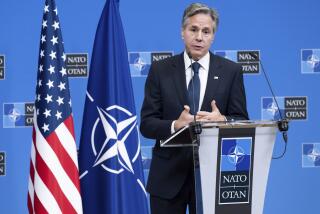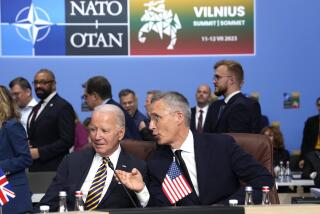With the Skies Clearing, NATO Broadens Assault
- Share via
WASHINGTON — With improving weather and additional warplanes carrying more effective bombs, the United States and its allies are stepping up an air campaign over Yugoslavia that has been badly hampered for nearly two weeks by cloud cover.
Officials say they have sharply increased the number of bombing targets in each of the last two days. They also have broadened the list of targets to include sites--such as bridges and utilities--that serve Yugoslavia’s civilians as well as its military.
And they say they are beginning--days later than many outside experts predicted--to directly engage Yugoslav ground forces that are attacking ethnic Albanians in the Balkan nation’s Kosovo province.
“We are just starting to hit them,” said British Air Commodore David Wilby, a NATO military spokesman in Brussels. “We are getting our tactics right . . . and taking the fight to them very hard.”
In recent days, U.S. officials have announced plans to double the deployment of F-117 Stealth fighters in the region, to a total of 24. U.S. officials also have said they will bolster the air campaign with 24 AH-64 Apache helicopters and ground-to-ground rocket systems, which will arrive within a week to intensify attacks on Yugoslav ground forces.
Other North Atlantic Treaty Organization countries also are boosting their forces: The Canadians have doubled their number of F/A-18 fighter-bombers in the theater, from six to 12. The British have stepped up their use of Tornado strike aircraft.
Bomb Releases Jets of Molten Metal
Sunday night’s airstrikes included 24 targets and were the “best we’ve seen since the first night of operations,” said U.S. Navy Capt. Steve Petropaoli, a Pentagon spokesman. In contrast to recent days, when heavy cloud cover blanketed the region, NATO used a “full range of systems,” including B-1 and B-2 bombers, F-117s, F-15E and F-16 tactical fighters, and other support aircraft.
For the new attack against ground forces, the five B-1 aircraft, based in England, are carrying a fearsome 8-foot bomb called the Combined Effects Munition, which is designed to destroy armored vehicles and to kill troops near them.
The CEM bomb releases thin jets of molten metal that pierce the top of armored vehicles to destroy them. Simultaneously, it sprays marble-sized shrapnel across the battlefield. It can thus clear a cluster of vehicles and troops, and is well suited to strike Yugoslav units, which have been maneuvering in small concentrations.
The better weather also is enabling the air forces to begin carrying several types of laser-guided weapons that have been useless in bad weather because clouds interfere with the laser targeting.
Though NATO members have been divided about how far to push the air campaign, over the weekend the alliance was fairly aggressive in the selection of its targets.
NATO warplanes struck a thermal heating plant that serves civilians, petrochemical refining facilities and the interior ministries in downtown Belgrade, the Serbian and Yugoslav capital. They also struck two bridges used by civilian and military traffic elsewhere in Yugoslavia.
Taking Pains to Avoid Civilians
The selection suggests that NATO is willing to strike a variety of “dual-use targets” as it continues its effort to bring the war close to home for the Yugoslav leadership. Officially, NATO won’t rule out any target connected with the Yugoslav government’s repression of ethnic Albanians, though officials say they are taking pains to avoid hitting civilians.
The targets have been picked with one signal in mind, said John Pike, a military analyst with the Federation of American Scientists: to convey to the Yugoslav army that NATO will work aggressively to block any attempt to bolster the forces in Kosovo from elsewhere in Serbia, the dominant Yugoslav republic.
NATO had been far less aggressive in the number of strikes it had ordered until the last few days, in the view of many outside analysts.
For most of the air campaign, NATO warplanes have flown about 50 combat missions a day, compared with 1,000 a day for the first week of the 1991 Persian Gulf War.
While the two conflicts are considerably different in nature, the current Operation Allied Force “has been carried out at a rather leisurely pace,” said Daniel Goure, a former U.S. defense official and an analyst at the Center for Strategic and International Studies in Washington.
So far, NATO has devoted a small share of its total aircraft to the job of attacking ground forces, a risky but increasingly important part of its mission.
Of a total of more than 400 aircraft, the NATO forces include fewer than 50 planes with close-range ground-attack capability: about a dozen A-10 “Warthogs,” 25 F-15E Eagle fighters and 12 British Harrier jets.
More to Read
Sign up for Essential California
The most important California stories and recommendations in your inbox every morning.
You may occasionally receive promotional content from the Los Angeles Times.














